A Report on the Impact of the Internet of Things on Modern Business
VerifiedAdded on 2021/02/20
|8
|2174
|171
Report
AI Summary
This report investigates the impact of the Internet of Things (IoT) on modern business operations, employing computer research methods to analyze its significance. It begins by outlining various computer-based research techniques, including qualitative and quantitative approaches, and then delves into different sampling techniques like probability and non-probability methods, emphasizing their application in computer-based projects. The report addresses ethical considerations in computer-based research, such as maintaining data confidentiality and participant dignity. It also explores various tools for data analysis, including SPSS and SAS, and thematic analysis. The core of the report presents a research proposal that includes aims and objectives focused on assessing the impact of IoT on business. It outlines a plan for data collection, using questionnaires to gather primary data from business managers, and reviews the feasibility of the proposal, concluding that the project is viable and can provide valuable insights into the influence of IoT on business growth and efficiency. Finally, it includes references to support the research.
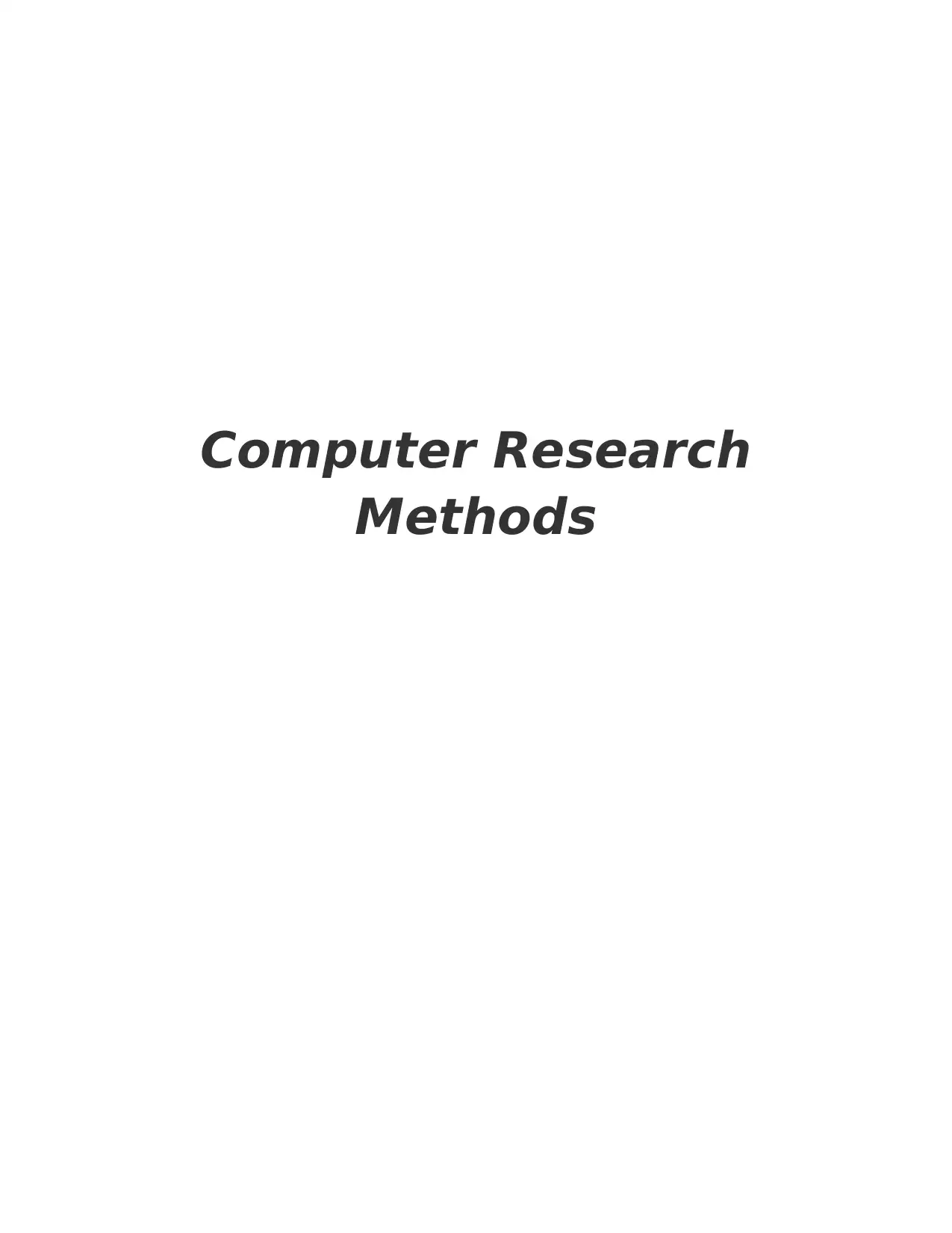
Computer Research
Methods
Methods
Paraphrase This Document
Need a fresh take? Get an instant paraphrase of this document with our AI Paraphraser
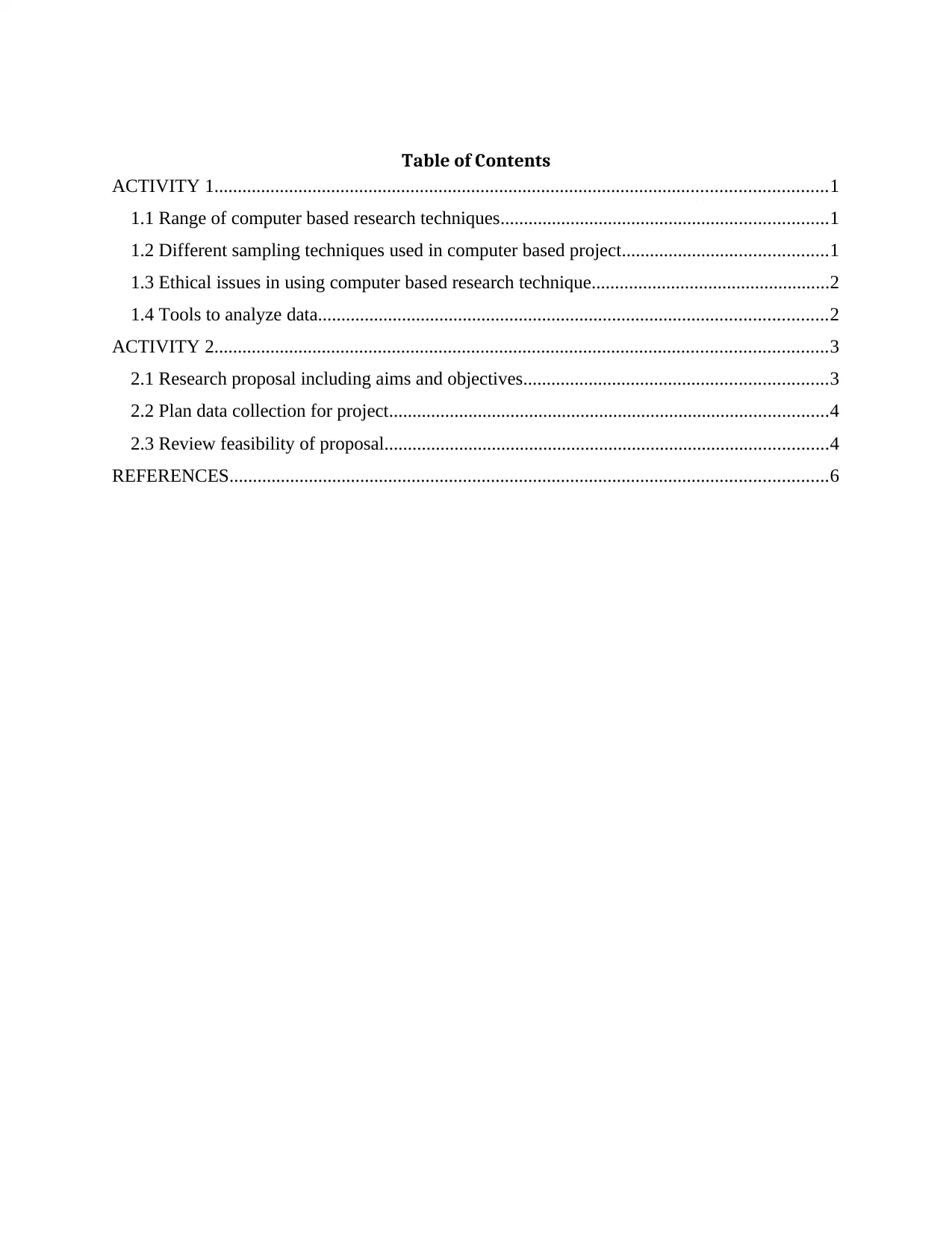
Table of Contents
ACTIVITY 1...................................................................................................................................1
1.1 Range of computer based research techniques......................................................................1
1.2 Different sampling techniques used in computer based project............................................1
1.3 Ethical issues in using computer based research technique...................................................2
1.4 Tools to analyze data.............................................................................................................2
ACTIVITY 2...................................................................................................................................3
2.1 Research proposal including aims and objectives.................................................................3
2.2 Plan data collection for project..............................................................................................4
2.3 Review feasibility of proposal...............................................................................................4
REFERENCES................................................................................................................................6
ACTIVITY 1...................................................................................................................................1
1.1 Range of computer based research techniques......................................................................1
1.2 Different sampling techniques used in computer based project............................................1
1.3 Ethical issues in using computer based research technique...................................................2
1.4 Tools to analyze data.............................................................................................................2
ACTIVITY 2...................................................................................................................................3
2.1 Research proposal including aims and objectives.................................................................3
2.2 Plan data collection for project..............................................................................................4
2.3 Review feasibility of proposal...............................................................................................4
REFERENCES................................................................................................................................6
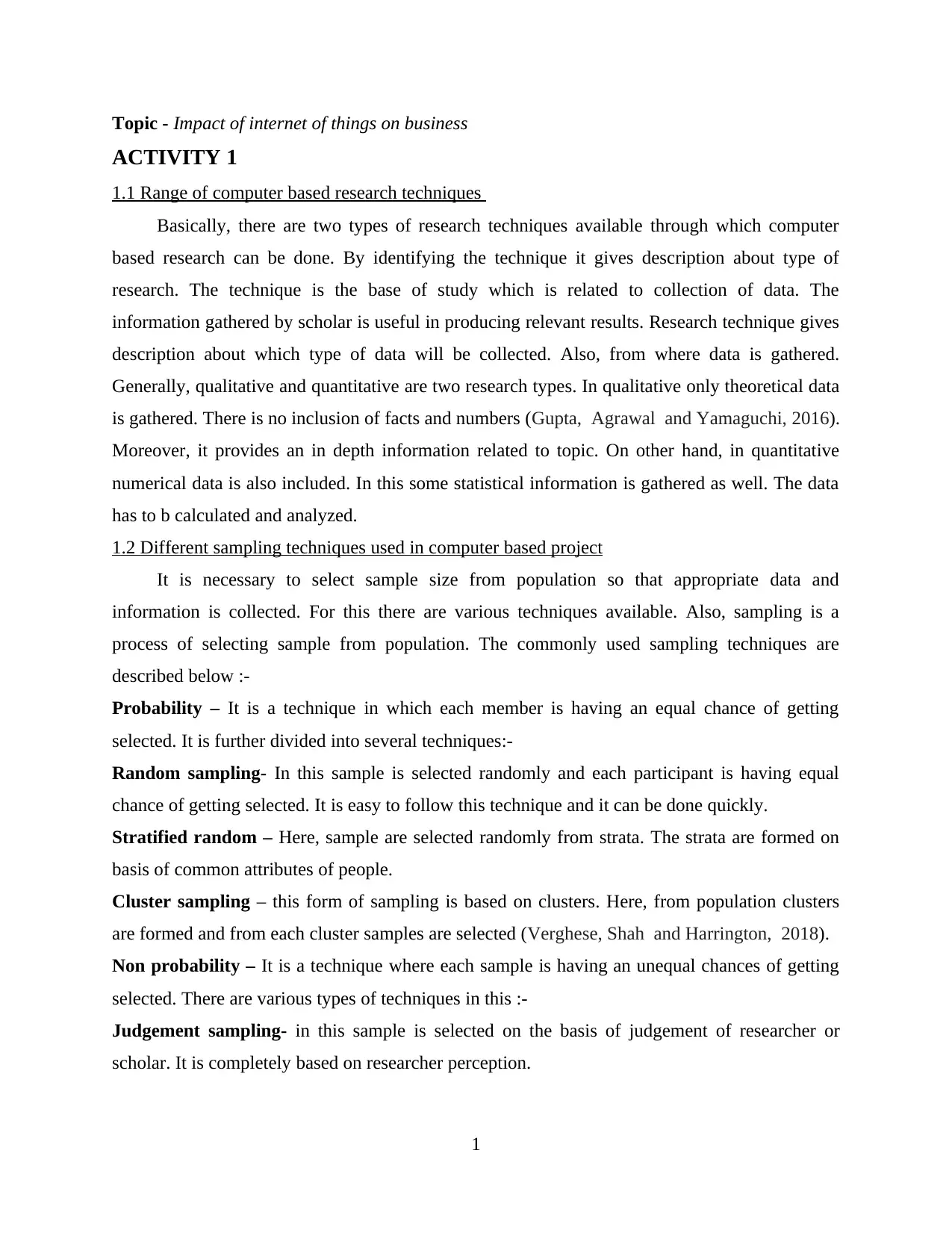
Topic - Impact of internet of things on business
ACTIVITY 1
1.1 Range of computer based research techniques
Basically, there are two types of research techniques available through which computer
based research can be done. By identifying the technique it gives description about type of
research. The technique is the base of study which is related to collection of data. The
information gathered by scholar is useful in producing relevant results. Research technique gives
description about which type of data will be collected. Also, from where data is gathered.
Generally, qualitative and quantitative are two research types. In qualitative only theoretical data
is gathered. There is no inclusion of facts and numbers (Gupta, Agrawal and Yamaguchi, 2016).
Moreover, it provides an in depth information related to topic. On other hand, in quantitative
numerical data is also included. In this some statistical information is gathered as well. The data
has to b calculated and analyzed.
1.2 Different sampling techniques used in computer based project
It is necessary to select sample size from population so that appropriate data and
information is collected. For this there are various techniques available. Also, sampling is a
process of selecting sample from population. The commonly used sampling techniques are
described below :-
Probability – It is a technique in which each member is having an equal chance of getting
selected. It is further divided into several techniques:-
Random sampling- In this sample is selected randomly and each participant is having equal
chance of getting selected. It is easy to follow this technique and it can be done quickly.
Stratified random – Here, sample are selected randomly from strata. The strata are formed on
basis of common attributes of people.
Cluster sampling – this form of sampling is based on clusters. Here, from population clusters
are formed and from each cluster samples are selected (Verghese, Shah and Harrington, 2018).
Non probability – It is a technique where each sample is having an unequal chances of getting
selected. There are various types of techniques in this :-
Judgement sampling- in this sample is selected on the basis of judgement of researcher or
scholar. It is completely based on researcher perception.
1
ACTIVITY 1
1.1 Range of computer based research techniques
Basically, there are two types of research techniques available through which computer
based research can be done. By identifying the technique it gives description about type of
research. The technique is the base of study which is related to collection of data. The
information gathered by scholar is useful in producing relevant results. Research technique gives
description about which type of data will be collected. Also, from where data is gathered.
Generally, qualitative and quantitative are two research types. In qualitative only theoretical data
is gathered. There is no inclusion of facts and numbers (Gupta, Agrawal and Yamaguchi, 2016).
Moreover, it provides an in depth information related to topic. On other hand, in quantitative
numerical data is also included. In this some statistical information is gathered as well. The data
has to b calculated and analyzed.
1.2 Different sampling techniques used in computer based project
It is necessary to select sample size from population so that appropriate data and
information is collected. For this there are various techniques available. Also, sampling is a
process of selecting sample from population. The commonly used sampling techniques are
described below :-
Probability – It is a technique in which each member is having an equal chance of getting
selected. It is further divided into several techniques:-
Random sampling- In this sample is selected randomly and each participant is having equal
chance of getting selected. It is easy to follow this technique and it can be done quickly.
Stratified random – Here, sample are selected randomly from strata. The strata are formed on
basis of common attributes of people.
Cluster sampling – this form of sampling is based on clusters. Here, from population clusters
are formed and from each cluster samples are selected (Verghese, Shah and Harrington, 2018).
Non probability – It is a technique where each sample is having an unequal chances of getting
selected. There are various types of techniques in this :-
Judgement sampling- in this sample is selected on the basis of judgement of researcher or
scholar. It is completely based on researcher perception.
1
⊘ This is a preview!⊘
Do you want full access?
Subscribe today to unlock all pages.

Trusted by 1+ million students worldwide
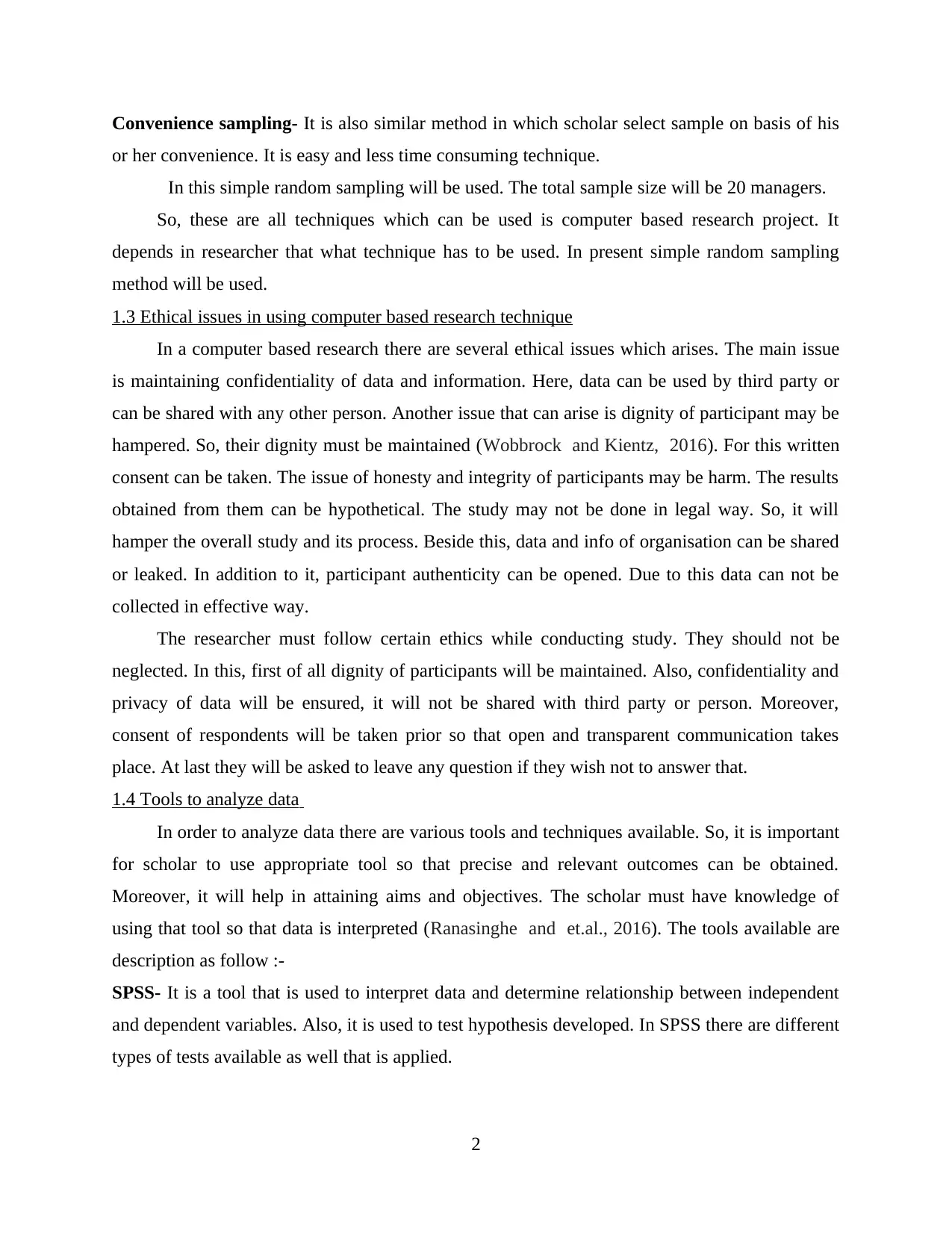
Convenience sampling- It is also similar method in which scholar select sample on basis of his
or her convenience. It is easy and less time consuming technique.
In this simple random sampling will be used. The total sample size will be 20 managers.
So, these are all techniques which can be used is computer based research project. It
depends in researcher that what technique has to be used. In present simple random sampling
method will be used.
1.3 Ethical issues in using computer based research technique
In a computer based research there are several ethical issues which arises. The main issue
is maintaining confidentiality of data and information. Here, data can be used by third party or
can be shared with any other person. Another issue that can arise is dignity of participant may be
hampered. So, their dignity must be maintained (Wobbrock and Kientz, 2016). For this written
consent can be taken. The issue of honesty and integrity of participants may be harm. The results
obtained from them can be hypothetical. The study may not be done in legal way. So, it will
hamper the overall study and its process. Beside this, data and info of organisation can be shared
or leaked. In addition to it, participant authenticity can be opened. Due to this data can not be
collected in effective way.
The researcher must follow certain ethics while conducting study. They should not be
neglected. In this, first of all dignity of participants will be maintained. Also, confidentiality and
privacy of data will be ensured, it will not be shared with third party or person. Moreover,
consent of respondents will be taken prior so that open and transparent communication takes
place. At last they will be asked to leave any question if they wish not to answer that.
1.4 Tools to analyze data
In order to analyze data there are various tools and techniques available. So, it is important
for scholar to use appropriate tool so that precise and relevant outcomes can be obtained.
Moreover, it will help in attaining aims and objectives. The scholar must have knowledge of
using that tool so that data is interpreted (Ranasinghe and et.al., 2016). The tools available are
description as follow :-
SPSS- It is a tool that is used to interpret data and determine relationship between independent
and dependent variables. Also, it is used to test hypothesis developed. In SPSS there are different
types of tests available as well that is applied.
2
or her convenience. It is easy and less time consuming technique.
In this simple random sampling will be used. The total sample size will be 20 managers.
So, these are all techniques which can be used is computer based research project. It
depends in researcher that what technique has to be used. In present simple random sampling
method will be used.
1.3 Ethical issues in using computer based research technique
In a computer based research there are several ethical issues which arises. The main issue
is maintaining confidentiality of data and information. Here, data can be used by third party or
can be shared with any other person. Another issue that can arise is dignity of participant may be
hampered. So, their dignity must be maintained (Wobbrock and Kientz, 2016). For this written
consent can be taken. The issue of honesty and integrity of participants may be harm. The results
obtained from them can be hypothetical. The study may not be done in legal way. So, it will
hamper the overall study and its process. Beside this, data and info of organisation can be shared
or leaked. In addition to it, participant authenticity can be opened. Due to this data can not be
collected in effective way.
The researcher must follow certain ethics while conducting study. They should not be
neglected. In this, first of all dignity of participants will be maintained. Also, confidentiality and
privacy of data will be ensured, it will not be shared with third party or person. Moreover,
consent of respondents will be taken prior so that open and transparent communication takes
place. At last they will be asked to leave any question if they wish not to answer that.
1.4 Tools to analyze data
In order to analyze data there are various tools and techniques available. So, it is important
for scholar to use appropriate tool so that precise and relevant outcomes can be obtained.
Moreover, it will help in attaining aims and objectives. The scholar must have knowledge of
using that tool so that data is interpreted (Ranasinghe and et.al., 2016). The tools available are
description as follow :-
SPSS- It is a tool that is used to interpret data and determine relationship between independent
and dependent variables. Also, it is used to test hypothesis developed. In SPSS there are different
types of tests available as well that is applied.
2
Paraphrase This Document
Need a fresh take? Get an instant paraphrase of this document with our AI Paraphraser
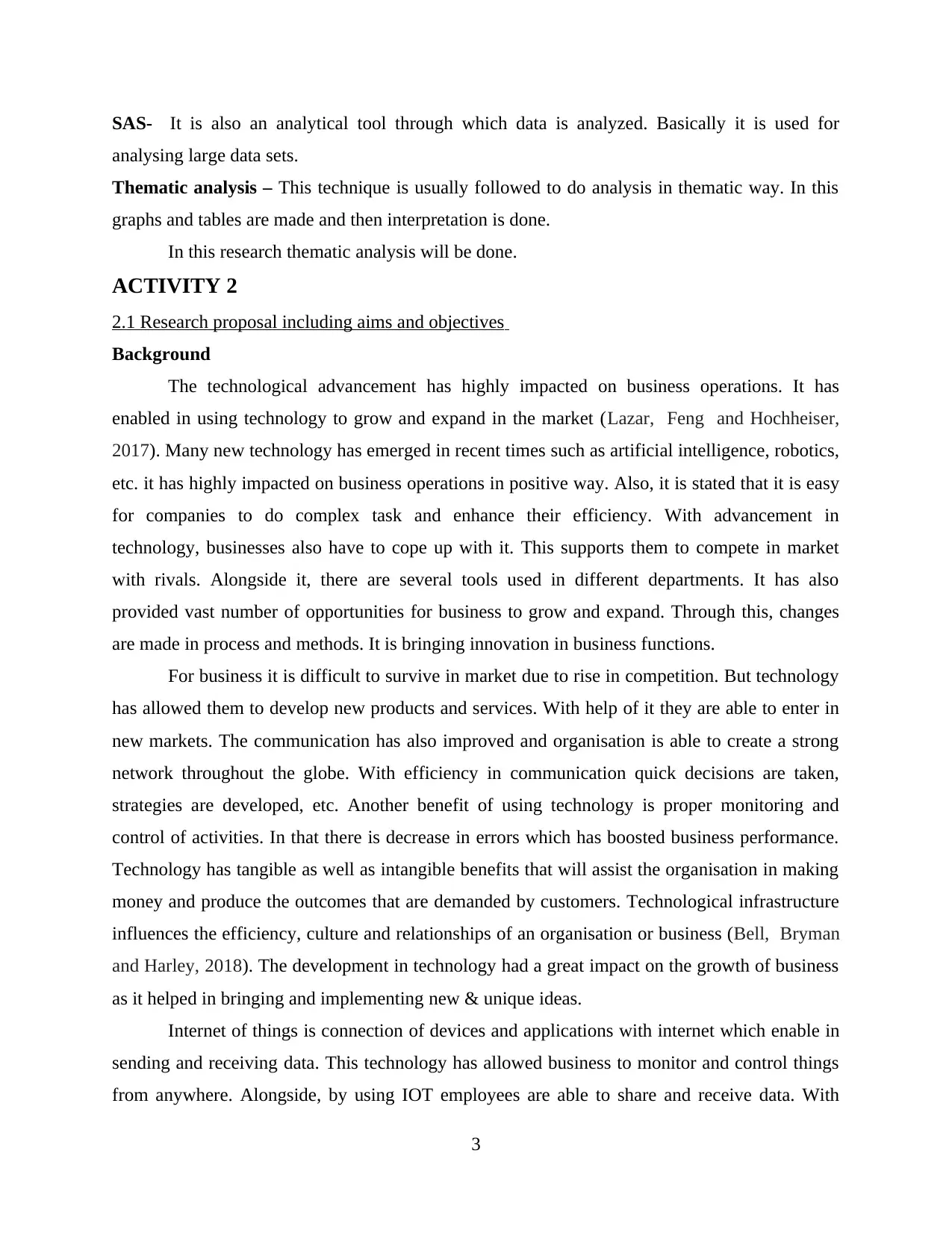
SAS- It is also an analytical tool through which data is analyzed. Basically it is used for
analysing large data sets.
Thematic analysis – This technique is usually followed to do analysis in thematic way. In this
graphs and tables are made and then interpretation is done.
In this research thematic analysis will be done.
ACTIVITY 2
2.1 Research proposal including aims and objectives
Background
The technological advancement has highly impacted on business operations. It has
enabled in using technology to grow and expand in the market (Lazar, Feng and Hochheiser,
2017). Many new technology has emerged in recent times such as artificial intelligence, robotics,
etc. it has highly impacted on business operations in positive way. Also, it is stated that it is easy
for companies to do complex task and enhance their efficiency. With advancement in
technology, businesses also have to cope up with it. This supports them to compete in market
with rivals. Alongside it, there are several tools used in different departments. It has also
provided vast number of opportunities for business to grow and expand. Through this, changes
are made in process and methods. It is bringing innovation in business functions.
For business it is difficult to survive in market due to rise in competition. But technology
has allowed them to develop new products and services. With help of it they are able to enter in
new markets. The communication has also improved and organisation is able to create a strong
network throughout the globe. With efficiency in communication quick decisions are taken,
strategies are developed, etc. Another benefit of using technology is proper monitoring and
control of activities. In that there is decrease in errors which has boosted business performance.
Technology has tangible as well as intangible benefits that will assist the organisation in making
money and produce the outcomes that are demanded by customers. Technological infrastructure
influences the efficiency, culture and relationships of an organisation or business (Bell, Bryman
and Harley, 2018). The development in technology had a great impact on the growth of business
as it helped in bringing and implementing new & unique ideas.
Internet of things is connection of devices and applications with internet which enable in
sending and receiving data. This technology has allowed business to monitor and control things
from anywhere. Alongside, by using IOT employees are able to share and receive data. With
3
analysing large data sets.
Thematic analysis – This technique is usually followed to do analysis in thematic way. In this
graphs and tables are made and then interpretation is done.
In this research thematic analysis will be done.
ACTIVITY 2
2.1 Research proposal including aims and objectives
Background
The technological advancement has highly impacted on business operations. It has
enabled in using technology to grow and expand in the market (Lazar, Feng and Hochheiser,
2017). Many new technology has emerged in recent times such as artificial intelligence, robotics,
etc. it has highly impacted on business operations in positive way. Also, it is stated that it is easy
for companies to do complex task and enhance their efficiency. With advancement in
technology, businesses also have to cope up with it. This supports them to compete in market
with rivals. Alongside it, there are several tools used in different departments. It has also
provided vast number of opportunities for business to grow and expand. Through this, changes
are made in process and methods. It is bringing innovation in business functions.
For business it is difficult to survive in market due to rise in competition. But technology
has allowed them to develop new products and services. With help of it they are able to enter in
new markets. The communication has also improved and organisation is able to create a strong
network throughout the globe. With efficiency in communication quick decisions are taken,
strategies are developed, etc. Another benefit of using technology is proper monitoring and
control of activities. In that there is decrease in errors which has boosted business performance.
Technology has tangible as well as intangible benefits that will assist the organisation in making
money and produce the outcomes that are demanded by customers. Technological infrastructure
influences the efficiency, culture and relationships of an organisation or business (Bell, Bryman
and Harley, 2018). The development in technology had a great impact on the growth of business
as it helped in bringing and implementing new & unique ideas.
Internet of things is connection of devices and applications with internet which enable in
sending and receiving data. This technology has allowed business to monitor and control things
from anywhere. Alongside, by using IOT employees are able to share and receive data. With
3
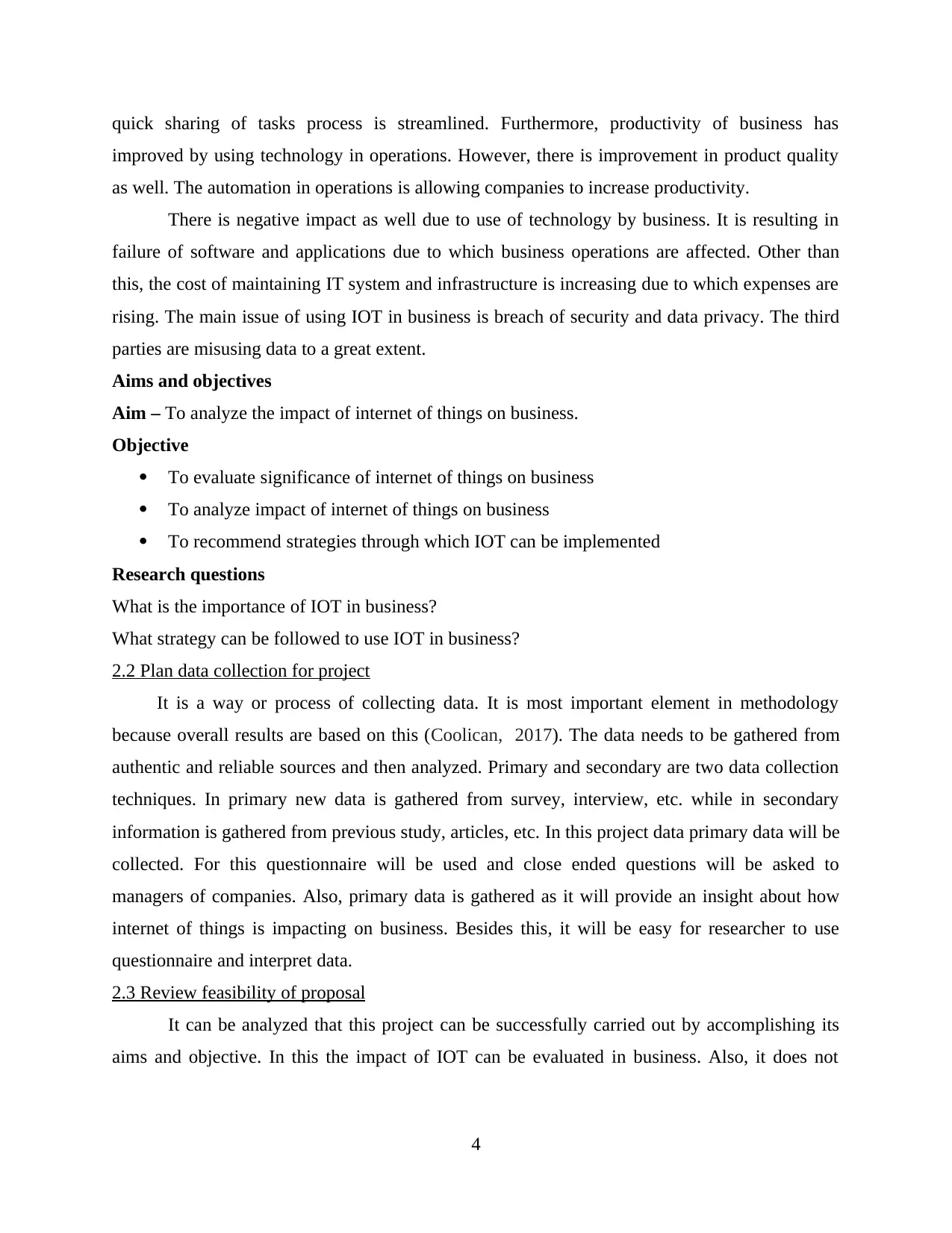
quick sharing of tasks process is streamlined. Furthermore, productivity of business has
improved by using technology in operations. However, there is improvement in product quality
as well. The automation in operations is allowing companies to increase productivity.
There is negative impact as well due to use of technology by business. It is resulting in
failure of software and applications due to which business operations are affected. Other than
this, the cost of maintaining IT system and infrastructure is increasing due to which expenses are
rising. The main issue of using IOT in business is breach of security and data privacy. The third
parties are misusing data to a great extent.
Aims and objectives
Aim – To analyze the impact of internet of things on business.
Objective
To evaluate significance of internet of things on business
To analyze impact of internet of things on business
To recommend strategies through which IOT can be implemented
Research questions
What is the importance of IOT in business?
What strategy can be followed to use IOT in business?
2.2 Plan data collection for project
It is a way or process of collecting data. It is most important element in methodology
because overall results are based on this (Coolican, 2017). The data needs to be gathered from
authentic and reliable sources and then analyzed. Primary and secondary are two data collection
techniques. In primary new data is gathered from survey, interview, etc. while in secondary
information is gathered from previous study, articles, etc. In this project data primary data will be
collected. For this questionnaire will be used and close ended questions will be asked to
managers of companies. Also, primary data is gathered as it will provide an insight about how
internet of things is impacting on business. Besides this, it will be easy for researcher to use
questionnaire and interpret data.
2.3 Review feasibility of proposal
It can be analyzed that this project can be successfully carried out by accomplishing its
aims and objective. In this the impact of IOT can be evaluated in business. Also, it does not
4
improved by using technology in operations. However, there is improvement in product quality
as well. The automation in operations is allowing companies to increase productivity.
There is negative impact as well due to use of technology by business. It is resulting in
failure of software and applications due to which business operations are affected. Other than
this, the cost of maintaining IT system and infrastructure is increasing due to which expenses are
rising. The main issue of using IOT in business is breach of security and data privacy. The third
parties are misusing data to a great extent.
Aims and objectives
Aim – To analyze the impact of internet of things on business.
Objective
To evaluate significance of internet of things on business
To analyze impact of internet of things on business
To recommend strategies through which IOT can be implemented
Research questions
What is the importance of IOT in business?
What strategy can be followed to use IOT in business?
2.2 Plan data collection for project
It is a way or process of collecting data. It is most important element in methodology
because overall results are based on this (Coolican, 2017). The data needs to be gathered from
authentic and reliable sources and then analyzed. Primary and secondary are two data collection
techniques. In primary new data is gathered from survey, interview, etc. while in secondary
information is gathered from previous study, articles, etc. In this project data primary data will be
collected. For this questionnaire will be used and close ended questions will be asked to
managers of companies. Also, primary data is gathered as it will provide an insight about how
internet of things is impacting on business. Besides this, it will be easy for researcher to use
questionnaire and interpret data.
2.3 Review feasibility of proposal
It can be analyzed that this project can be successfully carried out by accomplishing its
aims and objective. In this the impact of IOT can be evaluated in business. Also, it does not
4
⊘ This is a preview!⊘
Do you want full access?
Subscribe today to unlock all pages.

Trusted by 1+ million students worldwide
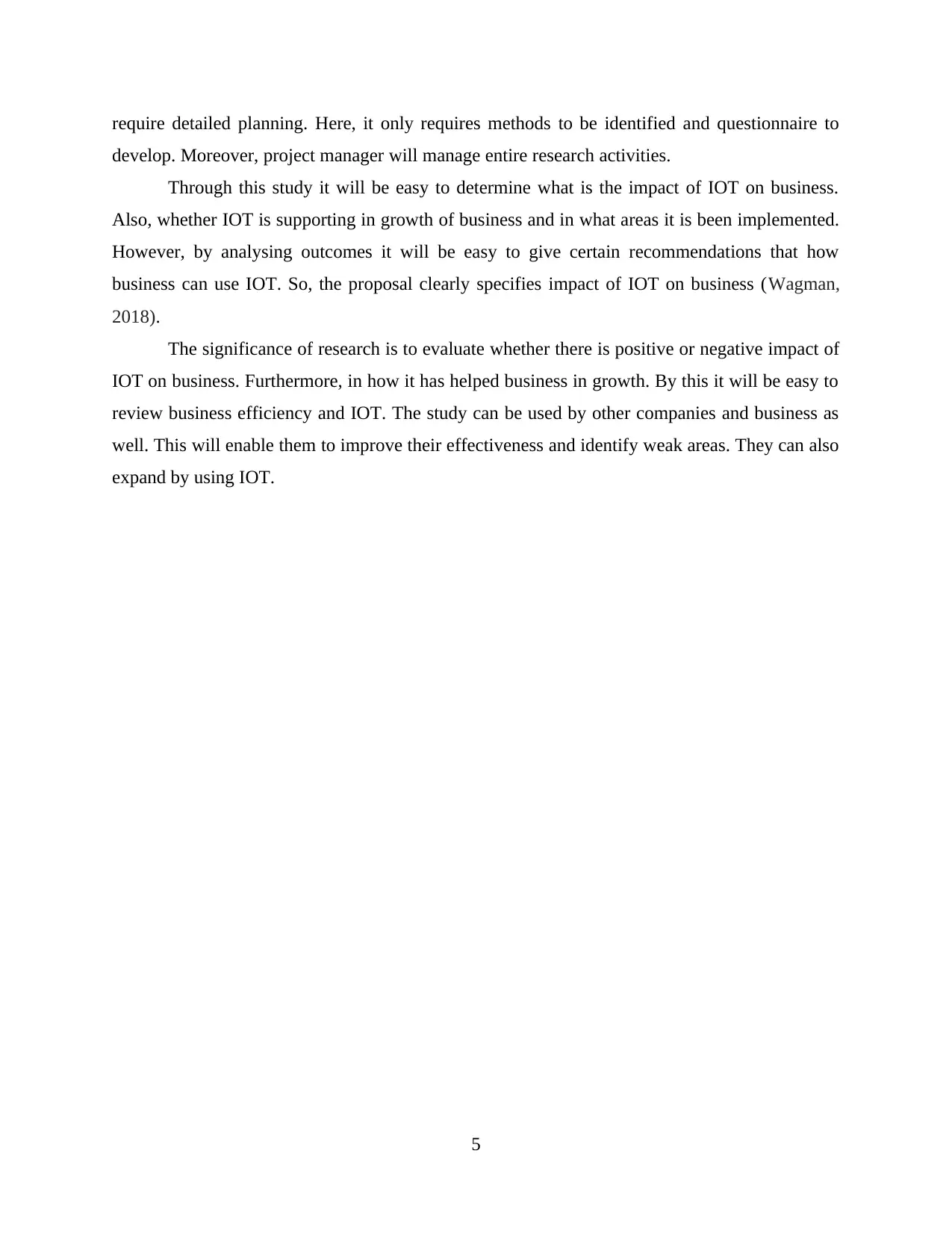
require detailed planning. Here, it only requires methods to be identified and questionnaire to
develop. Moreover, project manager will manage entire research activities.
Through this study it will be easy to determine what is the impact of IOT on business.
Also, whether IOT is supporting in growth of business and in what areas it is been implemented.
However, by analysing outcomes it will be easy to give certain recommendations that how
business can use IOT. So, the proposal clearly specifies impact of IOT on business (Wagman,
2018).
The significance of research is to evaluate whether there is positive or negative impact of
IOT on business. Furthermore, in how it has helped business in growth. By this it will be easy to
review business efficiency and IOT. The study can be used by other companies and business as
well. This will enable them to improve their effectiveness and identify weak areas. They can also
expand by using IOT.
5
develop. Moreover, project manager will manage entire research activities.
Through this study it will be easy to determine what is the impact of IOT on business.
Also, whether IOT is supporting in growth of business and in what areas it is been implemented.
However, by analysing outcomes it will be easy to give certain recommendations that how
business can use IOT. So, the proposal clearly specifies impact of IOT on business (Wagman,
2018).
The significance of research is to evaluate whether there is positive or negative impact of
IOT on business. Furthermore, in how it has helped business in growth. By this it will be easy to
review business efficiency and IOT. The study can be used by other companies and business as
well. This will enable them to improve their effectiveness and identify weak areas. They can also
expand by using IOT.
5
Paraphrase This Document
Need a fresh take? Get an instant paraphrase of this document with our AI Paraphraser
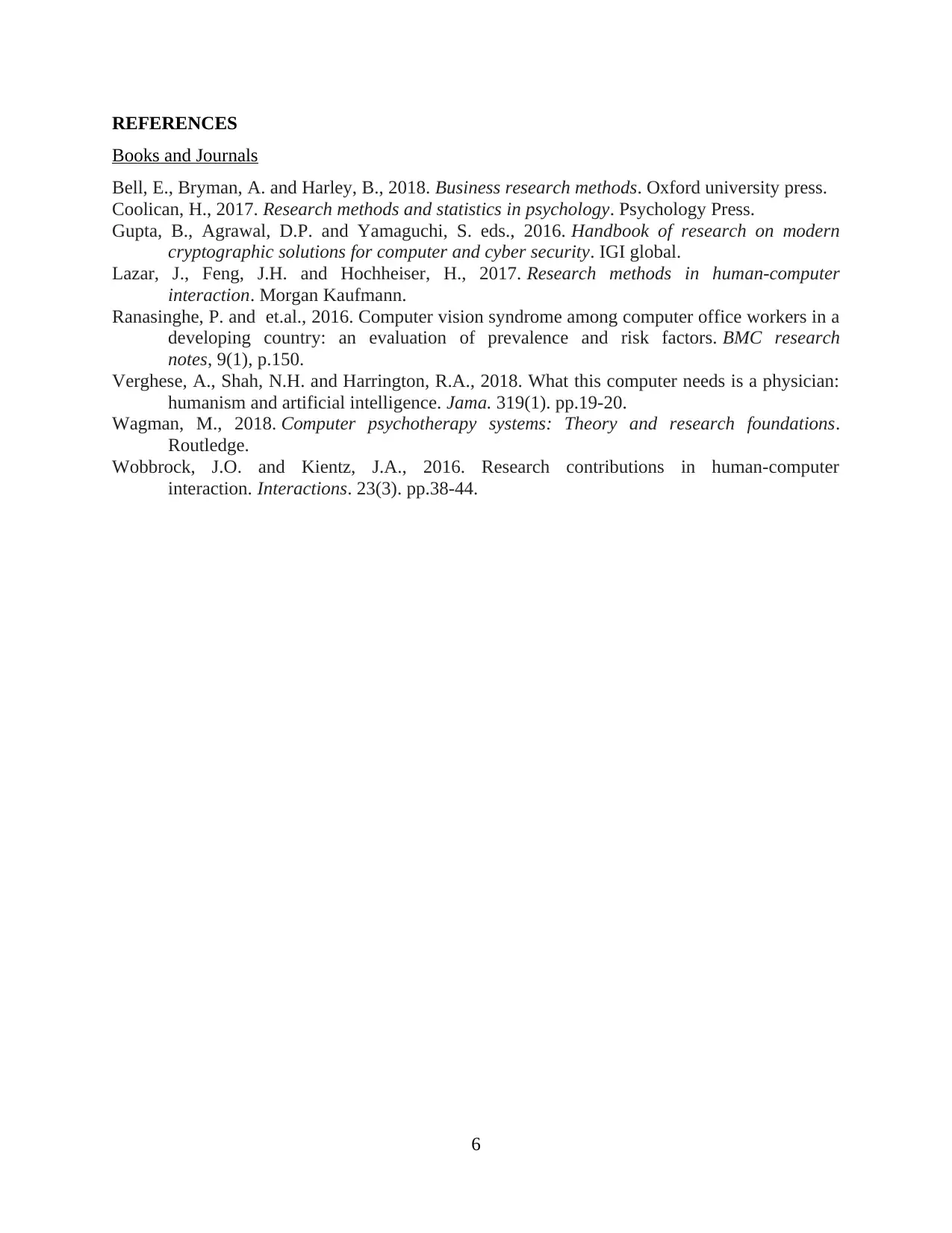
REFERENCES
Books and Journals
Bell, E., Bryman, A. and Harley, B., 2018. Business research methods. Oxford university press.
Coolican, H., 2017. Research methods and statistics in psychology. Psychology Press.
Gupta, B., Agrawal, D.P. and Yamaguchi, S. eds., 2016. Handbook of research on modern
cryptographic solutions for computer and cyber security. IGI global.
Lazar, J., Feng, J.H. and Hochheiser, H., 2017. Research methods in human-computer
interaction. Morgan Kaufmann.
Ranasinghe, P. and et.al., 2016. Computer vision syndrome among computer office workers in a
developing country: an evaluation of prevalence and risk factors. BMC research
notes, 9(1), p.150.
Verghese, A., Shah, N.H. and Harrington, R.A., 2018. What this computer needs is a physician:
humanism and artificial intelligence. Jama. 319(1). pp.19-20.
Wagman, M., 2018. Computer psychotherapy systems: Theory and research foundations.
Routledge.
Wobbrock, J.O. and Kientz, J.A., 2016. Research contributions in human-computer
interaction. Interactions. 23(3). pp.38-44.
6
Books and Journals
Bell, E., Bryman, A. and Harley, B., 2018. Business research methods. Oxford university press.
Coolican, H., 2017. Research methods and statistics in psychology. Psychology Press.
Gupta, B., Agrawal, D.P. and Yamaguchi, S. eds., 2016. Handbook of research on modern
cryptographic solutions for computer and cyber security. IGI global.
Lazar, J., Feng, J.H. and Hochheiser, H., 2017. Research methods in human-computer
interaction. Morgan Kaufmann.
Ranasinghe, P. and et.al., 2016. Computer vision syndrome among computer office workers in a
developing country: an evaluation of prevalence and risk factors. BMC research
notes, 9(1), p.150.
Verghese, A., Shah, N.H. and Harrington, R.A., 2018. What this computer needs is a physician:
humanism and artificial intelligence. Jama. 319(1). pp.19-20.
Wagman, M., 2018. Computer psychotherapy systems: Theory and research foundations.
Routledge.
Wobbrock, J.O. and Kientz, J.A., 2016. Research contributions in human-computer
interaction. Interactions. 23(3). pp.38-44.
6
1 out of 8
Related Documents
Your All-in-One AI-Powered Toolkit for Academic Success.
+13062052269
info@desklib.com
Available 24*7 on WhatsApp / Email
![[object Object]](/_next/static/media/star-bottom.7253800d.svg)
Unlock your academic potential
Copyright © 2020–2025 A2Z Services. All Rights Reserved. Developed and managed by ZUCOL.





